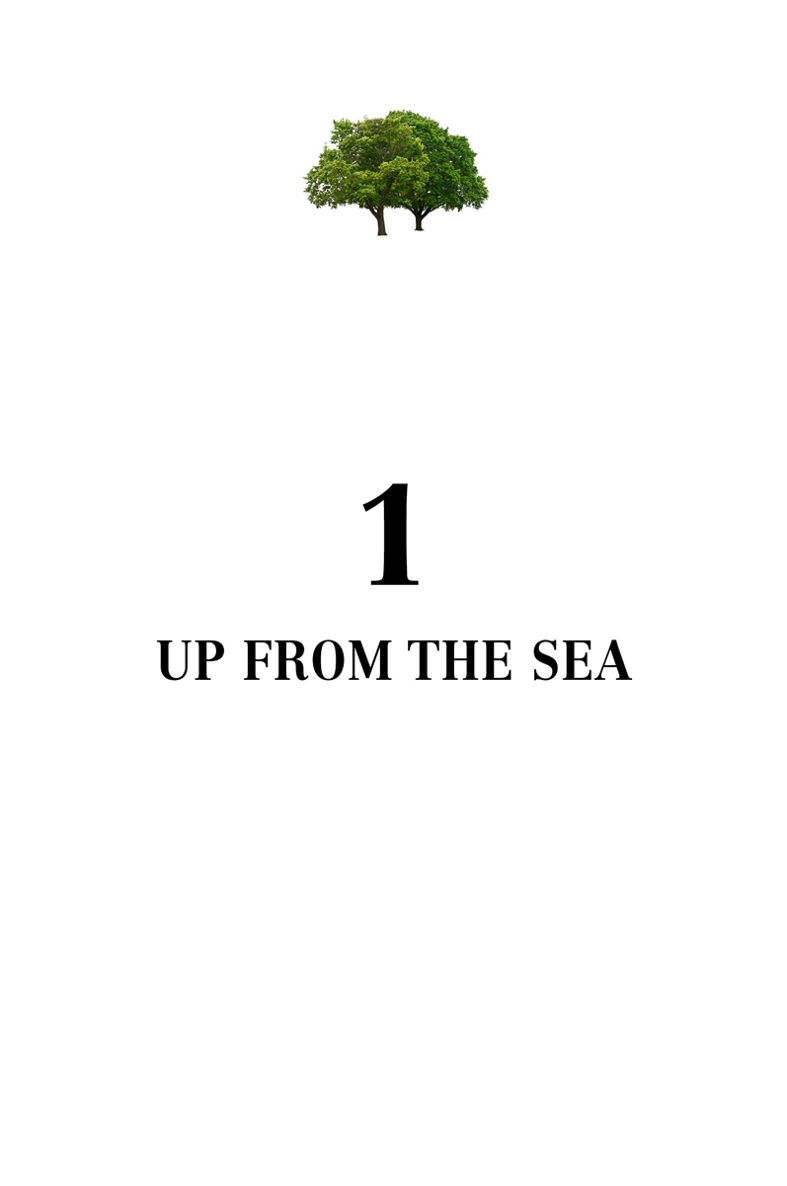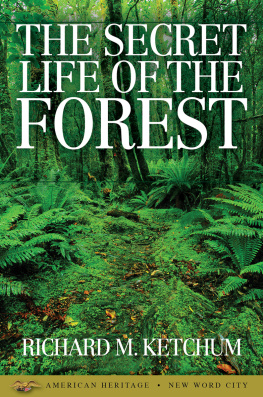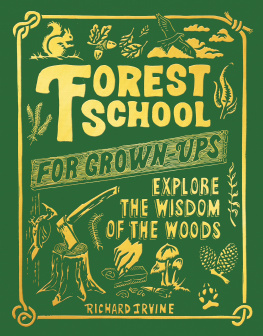Richard M Ketchum - The Secret Life of the Forest
Here you can read online Richard M Ketchum - The Secret Life of the Forest full text of the book (entire story) in english for free. Download pdf and epub, get meaning, cover and reviews about this ebook. year: 2017, publisher: American Heritage Press, genre: Science. Description of the work, (preface) as well as reviews are available. Best literature library LitArk.com created for fans of good reading and offers a wide selection of genres:
Romance novel
Science fiction
Adventure
Detective
Science
History
Home and family
Prose
Art
Politics
Computer
Non-fiction
Religion
Business
Children
Humor
Choose a favorite category and find really read worthwhile books. Enjoy immersion in the world of imagination, feel the emotions of the characters or learn something new for yourself, make an fascinating discovery.
- Book:The Secret Life of the Forest
- Author:
- Publisher:American Heritage Press
- Genre:
- Year:2017
- Rating:5 / 5
- Favourites:Add to favourites
- Your mark:
- 100
- 1
- 2
- 3
- 4
- 5
The Secret Life of the Forest: summary, description and annotation
We offer to read an annotation, description, summary or preface (depends on what the author of the book "The Secret Life of the Forest" wrote himself). If you haven't found the necessary information about the book — write in the comments, we will try to find it.
The Secret Life of the Forest — read online for free the complete book (whole text) full work
Below is the text of the book, divided by pages. System saving the place of the last page read, allows you to conveniently read the book "The Secret Life of the Forest" online for free, without having to search again every time where you left off. Put a bookmark, and you can go to the page where you finished reading at any time.
Font size:
Interval:
Bookmark:

Trees, like all other forms of life, trace their origins to the sea. To understand how the first tree appeared on Earth, we must look back more than 3 billion years to Earths cooling off and changing from a molten sphere to one that had a solid crust.
As it cooled, a thin layer of granite formed over the fiery interior; the hot inner mass contracted; ridges were thrust upward to form mountains; molten lava surged up through cracks, and boiling water rose to the surface. As hot springs that even now gush up out of the Earth show, this process is still going on; geysers and active volcanoes testify to the searing heat that prevails far inside the earth. Scientists believe the water in our oceans today was first released by volcanic action as a gas, which formed the primeval atmosphere. When this vapor reached extremely high altitudes, it condensed into water and fell Earthward. For a long time, however, because the atmospheric temperature was so hot, it resumed its gaseous form before reaching the planet, but eventually, the surface cooled enough so that water began accumulating in liquid form.
And then, for literally millions and millions of years, it must have rained continuously, the water sweeping minerals down from the rocks and filling the depressions in the Earths face. For as much as half of its total existence, the world was barren of life. No living thing stirred anywhere. And then, perhaps 2 billion years ago, life began, and eventually, the congenial ocean environment became a primeval soup, teeming with minute organic materials. For millions of years, these simple, organic compounds - a blend of the gases and minerals that had come from the Earths interior and from the atmosphere - combined and interacted. As they did so, distinctive features of living organisms began to emerge; cell membranes were formed, and finally, there developed reproduction.
Some of the organisms that were the ancestors of plants found a means of using sunlight as a source of energy - photosynthesis - which enabled them to survive and prosper in an inorganic environment. Photosynthesis, the activity that ultimately makes all life possible, permits plants to trap energy from the sun and store it in the form of glucose, or sugar, for their growth. To make one molecule of sugar requires six molecules of water and six of carbon dioxide, taken from the air. When these are combined with the energy from the suns light, glucose is formed - to be stored within the plant - and oxygen and carbon dioxide are released into the air. As minute organisms became more plentiful, increasing quantities of oxygen began to be thrown off and built up in the Earths environment. Since oxygen in its free form is highly poisonous to most organic molecules, only those primitive organisms able to tolerate it could survive, and they gradually evolved a method of using oxygen in a new kind of energy cycle.
Unlike geology or zoology where fossil remains tell the story of early life, the beginnings of plant life are lost in the mists of time, and the study of the first plants rests upon conjecture and educated guesses. (Fossils do not appear in any quantity until the beginning of the Cambrian period, about 600 million years ago. These remains do not mean that life suddenly appeared at that time - only that many forms of life, such as plants, did not acquire hard parts capable of preservation until then.) The sea originally occupied a much larger area than it now does, but it was quite shallow; we can surmise that at some distant time the original plant cells evolved near the surface of the ocean, or in its offshore waters, and that these first cells became the basis for higher plants.
A plant has been defined as a living thing that absorbs in microscopic amounts over its surface all that it needs for growth. Through an unimaginably long and complicated process, the first genuine plant forms began to take shape in shallow sea waters and ultimately moved out of marsh and estuary onto the land, adapting themselves into forms capable of surviving on the inhospitable coastlines. We do not know how plants made their transition from water to land, but at some point, seaweeds or some borderline plant forms must have begun to grow onto the muddy shores and into the air and found a way of anchoring themselves there when the waters ebbed. After leaving the friendlier surroundings of the oceans, plants were exposed to a vastly more complicated environment in which difficult conditions of survival forced them to adopt complex forms. Struggling into the unfamiliar dry air, standing up to the rigors of sun and wind, required entirely new mechanisms in order to endure. Even today we can see remnants of the changes that took place: Simple, primitive forms are still found alongside the most sophisticated varieties of plants, and plants with all the characteristics of sea organisms are discovered on a mountaintop, far removed from the ocean. Lichens, for example, are the hardiest of pioneers; because they are not dependent upon soil, these remnants of a prehistoric time grow farther north and higher above the timberline than any other plant.
On land, conditions differed markedly from those in the sea, and before plants could grow in any quantity, the soil had to be created. Minerals in the molten rock squirted upward, usually following cracks made by earthquakes, sometimes erupting in volcanic blasts, and most of the atmosphere and the water came from these vents . The long, slow process of soil-building began on the first rocky surface. As the forces of nature broke up rocks, the suns warmth caused them to expand, and water created larger fissures in the Earths face. The constant cycle of heating, cooling, soaking, and drying opened little cracks and pockets into which bits of loose rubble and minerals settled. Wind and water swept stony fragments from the mountains; water and ice ground them into smaller pieces, and storms picked them up and deposited them miles from their original location. In areas near the sea, the deposits of one season were exposed to the air as the floodwaters receded; when the next rainy season came along, the surface was again flooded by water, which carved out new channels in vulnerable soft spots, and as the waters once more lost their force, mud and sand were deposited, forming a layer of rich sediment. The soil mantle deepened with the passage of millions of years, and the individual particles became increasingly finer. Water seeping through the layer of soil carried tiny pieces of mineral-laden dirt downward, gradually creating subsoil. Primitive plants found a foothold in crevices and cracks and began to spread. There was still no animal life on land, nor could it exist until there was sufficient plant life for a food supply. For millions of years, the landscape was a monotonous brown, broken only by the spreading green tide of vegetation; there were no flowers to give it color, no sound of animals or birds.
The most important surviving relics of the primitive plants are mosses and ferns, which give us a clue to how ancient plants solved the problem of reproduction. They developed spores, or microscopic cells, which fell into the water, germinated, and formed male and female sex organisms that combined to create a new plant. Spores are relatively inefficient: It takes thousands of them to form the almost invisible dust on the underside of a fern leaf, and when these are released, only a few of them ever lodge in a place that offers the combination of sunlight and moisture they need to develop.
Eventually, other forms of plant life appeared on the Earths bleak crust. With the passage of time, debris from all these plants fell to the surface, adding to the depth of the soil; other, more complex plants appeared, and microorganic forms of life began. And somewhere, somehow, the ancestor of the first tree grew from the thinly covered rock. It was probably not much more than two feet tall, with a puny stem and no true leaves, but it towered above the other plants of its time and stood up to the wind that swept across the barren surface of the world. It was the culmination of hundreds of millions of years of evolution, and it was able to stand on its own, above the other plants, because it embodied a woody structure that supported it in its upward struggle toward the sunlight.
Font size:
Interval:
Bookmark:
Similar books «The Secret Life of the Forest»
Look at similar books to The Secret Life of the Forest. We have selected literature similar in name and meaning in the hope of providing readers with more options to find new, interesting, not yet read works.
Discussion, reviews of the book The Secret Life of the Forest and just readers' own opinions. Leave your comments, write what you think about the work, its meaning or the main characters. Specify what exactly you liked and what you didn't like, and why you think so.











